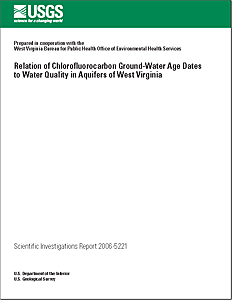West Virginia Water Science Center
Relation of Chlorofluorocarbon Ground-Water Age Dates to Water Quality in Aquifers of West VirginiaIn Cooperation with the West Virginia Bureau for Public Health Office of Environmental Health ServicesBy Kurt J. McCoy and Mark D. KozarScientific Investigations Report 2006-5221 |

|
This publication is downloadable in PDF format.
To view or print PDF files, the freely downloadable Adobe Acrobat Reader® may be used.
The average apparent age of ground water in fractured-bedrock aquifers in West Virginia was determined using chlorofluorocarbon (CFC) dating methods. Since the introduction of CFC gases as refrigerants in the late 1930s, atmospheric concentrations have increased until production ceased in the mid-1990s. CFC dating methods are based on production records that date to the early 1940s, and the preservation of atmospheric CFC concentrations in ground water at the time of recharge. As part of the U.S. Geological Survey (USGS) National Water-Quality Assessment (NAWQA) and Ambient Ground-Water Monitoring Network (AGN) programs in West Virginia from 1997 to 2005, 80 samples from the Appalachian Plateaus Physiographic Province, 27 samples from the Valley and Ridge Physiographic Province, and 5 samples from the Ohio River alluvial aquifers were collected to estimate ground-water ages in aquifers of West Virginia.
Apparent CFC ages of water samples from West Virginia aquifers ranged from 5.8 to 56 years. In the Appalachian Plateaus, topographically driven ground-water flow is evident from apparent ages of water samples from hilltop, hillside, and valley settings (median apparent ages of 12, 14, and 25 years, respectively). Topographic setting was the only factor that was found to be related to apparent ground-water age in the Plateaus at the scale of this study. Similar relations were not found in Valley and Ridge aquifers, indicating that other factors such as bedding or geologic structure may serve larger roles in controlling ground-water flow in that physiographic province.
Degradation of CFCs was common in samples collected from methanogenic/anoxic aquifers in the Appalachian Plateaus and suboxic to anoxic aquifers in the Valley and Ridge. CFC contamination was most common in Ohio River alluvial aquifers and carbonate units of the Valley and Ridge, indicating that these highly transmissive surficial aquifers are the most vulnerable to water-quality degradation and may contain wastewater from domestic or industrial sources with CFC concentrations greater than modern atmospheric levels. However, based on a lack of detections of the volatile organic compounds analyzed for in most of the water samples collected for this and similar USGS investigations, ground-water resources of West Virginia used for public and private consumption do not appear to be routinely affected by anthropogenic activities despite their young apparent age.
Abstract
Introduction
Purpose and Scope
Chlorofluorocarbon Age Dating
Aquifer Systems of West Virginia
Appalachian Plateaus Aquifer System
Valley and Ridge Aquifer System
Ohio River Alluvial Aquifer System
Methods of Ground-Water Sample Collection and Analysis
Water-Quality Constituents
Dissolved Gases
Chlorofluorocarbons
Chlorofluorocarbon Ground-Water Age Dates
Estimates of Recharge Temperature Based on Dissolved-Gas Concentration
Apparent Ground-Water Ages
Statewide Assessment of Apparent Ages
Relation of Ground-Water Age to Water Quality
Summary and Conclusions
Acknowledgments
References Cited
Download: PDF of SIR2006-5221 (1.4Mb).